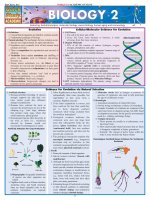- Trang chủ >>
- Khoa Học Tự Nhiên >>
- Vật lý
LASER LIGHT DYNAMICS vol 2 HAKEN
Bạn đang xem bản rút gọn của tài liệu. Xem và tải ngay bản đầy đủ của tài liệu tại đây (4.94 MB, 354 trang )
H. HAKEN
- -
LASER TIGHTDYNAMICS
NOR]H HOttAND
LIGHT
Volume
2
LASER
LIGHT
DYNAMICS
H.
HAKEN
It!
jrirut
fur
Theoretische Physik, Stuttgart
\ORTH-HOLLAND PHYSICS PUBLISHING
if1STERDAM. NEW
YORK
.
OXFORD. TOKYO
Preface to the Preface
Dear Reader,
Before you read this book, and even its preface, the following remarks
might be useful to you. Since this book is
"
Volume
2"
you may be inclined
to believe that you must know all the contents of
"
Volume 1" before you
can start reading (and, of course, understanding)
"
Volume
2".
But this is
not the case. The present
"
Volume
2"
again starts at a rather elementary
level, and then proceeds step by step to more difficult matters. Only at these
later stages some more advanced theoretical background is required which
then can be taken from
"
Volume I".
I
have chosen this way of presentation
to make the theory of laser light accessible to a broad audience
-
ranging
from students at the beginning of their graduate studies to professors and
scientists interested in recent developments. For details on the relations
between the chapters of these books consult the list at the end of the
introduction.
H.
Haken
Preface
This book is a text which applies to students and professors of physics.
Because it offers a broad view on laser physics and presents most recent
results on the dynamics of laser light, such as self
-
pulsing and chaos, it will
be of interest also to scientists and engineers engaged in laser research or
development. This text starts at a rather elementary level and will smoothly
lead the reader into the more difficult problems of laser physics, including
the basic features of the coherence and noise properties of laser light.
In the introductory chapters, typical experimental set
-
ups and laser
materials will
be
discussed, but the main part of this book will be devoted
to a
theoretical treatment
of a great variety of laser processes. The laser, or
the optical maser, as it was originally called, is one of the most important
inventions of this century and has found a great number of important
applications in physics, chemistry, medicine, engineering, telecommunica
-
tions, and other fields. It bears great promises for further applications, e.g.
in computers. But also from the point of view of basic research,
a
study of
the physical processes which produce the unique properties of laser light
are equally fascinating. The laser is a beautiful example of a system far
from thermal equilibrium which can achieve a macroscopically ordered
state through
"
self
-
organization
"
. It was the first example for a nonequili-
brium phase transition, and its study eventually gave birth to synergetics,
a new interdisciplinary field of research.
I
got involved in laser physics at a rather early stage and under most
fortunate circumstances. In 1960 I was working as visiting scientist at the
Bell Telephone Laboratories, Murray Hill. There
I
soon learned that these
laboratories were searching for a revolutionary new light source. Two years
earlier, in 1958, this source had been proposed by Schawlow and Townes,
who derived in particular the laser condition and thus demonstrated the
feasibility of this new device. At Bell Telephone Laboratories I soon got
involved in a theoretical study of the laser processes and continued it at
Stuttgart University. I developed a laser theory whose basic features I
published in 1962 and which I then applied to various concrete problems,
viii
Preface
jointly with my coworkers. At about the same time, in 1964, Willis Lamb
published his theory, which he and his coworkers applied to numerous
problems. It is by now well known that these two theories, which are called
semiclassical and which were developed independently, are equivalent. The
next step consisted in the development of the laser quantum theory which
allows one to predict the coherence and noise properties of laser light (and
that of light from lamps). This theory which I published in 1964 showed
for the first time that the statistical properties of laser light change dramati
-
cally at laser threshold. In the following years my group in Stuttgart carried
this work further,
e.g. to predict the photon statistics close to laser threshold.
From 1965 on, Scully and Lamb started publishing their results on the
quantum theory of the laser, using a different approach, and Lax and
Louise11 presented their theory. Again, all of these theories eventually turned
out to be more or less equivalent. In those years experimental laser physics
developed (and is still developing) at an enormous pace, but because I shall
mainly deal with laser
theory
in this book,
I
have to cut out a representation
of the history of that field.
From my above personal reminiscences it may transpire that laser theory
and, perhaps still more, laser physics in general have been highly competitive
fields of research. But, what counts much more, laser physics has been for
us all a fascinating field of research. When one looks around nowadays,
one can safely say that is has lost nothing of its original fascination. Again
and again new laser materials are found, new experimental set
-
ups invented
and new effects predicted and discovered. Undoubtedly, for many years to
come, laser physics will remain a highly attractive and important field of
research, in which fundamental problems are intimately interwoven with
applications of great practical importance. I hope that this book will let
transpire the fascination of this field.
Over the past nearly 25 years
I
greatly profited from the cooperation or
discussion with numerous scientists and I use this oppprtunity to thank all
of them. There is Wolfgang Kaiser, who was the first at BTL with whom I
had discussions on the laser problem. Then there are the members of my
group at Stuttgart who in the sixties, worked on laser theory and who gave
important contributions. I wish to mention in particular R. Graham,
H.
Geffers, H. Risken,
H.
Sauermann, Chr. Schmid,
H.D.
Vollmer, and W.
Weidlich. Most of them now have their own chairs at various universities.
Among my coworkers who, in later years, contributed to laser theory and
its applications are in particular
J.
Goll, A. Schenzle,
H.
Ohno, A. Wunderlin
and
J.
Zorell. Over the years I enjoyed many friendly and stimulating
discussions with
F.T.
Arecchi, W.R. Bennett, Jr.,
N.
Bloembergen,
R. Bonifacio,
J.H.
Eberly, C.G.B. Garret, R.J. Glauber,
F.
Haake, Yu.
Preface
ix
Klimontovich, W. Lamb,
M.
Lax, W. Louisell,
L.
Lugiato,
L.
Mandel,
L.
Narducci,
E.R.
Pike, M. Sargent,
M.
Scully, S. Shimoda, S. Stenholm,
Z.C. Wang,
E.
Wolf,
J.
Zhang, and many other scientists.
I
wish to thank my coworker, Dr.
H.
Ohno, for his continuous and
valuable assistance in the preparation of the manuscript. In particular, he
carefully checked the formulas and exercises, contributed some in addition,
and drew the figures. My particular thanks go to my secretary, Mrs.
U.
Funke, who in spite of her heavy administrative work assisted me in many
ways in writing the manuscript and typed various versions of it both rapidly
and perfectly. Her indefatigable zeal constantly spurred me on to bring it
to a finish.
The writing of this book was greatly helped by a program of the Deutsche
Forschungsgemeinschaft. This program was initiated by Prof. Dr.
Maier-
Leibnitz, whom
I
wish to thank cordially for his support for this project.
H.
Haken
Contents
Preface to the preface
Preface
Contents
List of symbols
Introduction
The maser and laser principle
The problems of laser theory
The structure of laser theory and its representation in this
book
Basic properties and types of lasers
The laser condition
Typical properties of laser light
Examples of laser systems (types of lasers and laser
processes)
Laser resonators
Survey
Modes in a confocal resonator
Modes in a Fabry
-
Perot resonator
The intensity of laser light. Rate equations
Introduction
The photon model of a single mode laser
Relaxation oscillations
Q
-
switching
v
vii
xi
xv
xii
Contents
The basic rate equations of the multimode laser
Hole burning. Qualitative discussion
Quantitative treatment of hole burning. Single mode laser
action of an
inhomogeneously broadened line
Spatial hole burning. Qualitative discussion
The multimode laser. Mode competition and Darwin's
survival of the fittest
The coexistence of modes due to spatial hole burning.
Quantitative treatment
The basic equations of the semiclassical laser theory
Introduction
Derivation of the wave equation for the electric field
strength
The matter equations
The semiclassical laser equations for the macroscopic
quantities electric field strength, polarization, and inversion
density
The laser equations in a resonator
Two important approximations: The rotating wave
approximation and the slowly varying amplitude
approximation
The semiclassical laser equations for the macroscopic
quantities electric field strength, polarization, and inversion
density in the rotating wave
-
and slowly varying amplitude
approximations
Dimensionless quantities for the light field and introduction
of a coupling constant
The basic laser equations
Applications of semiclassical theory
The single mode laser. Investigation of stability
Single mode laser action. Amplitude and frequency of laser
light in the stationary state
The single mode laser: Transients
Multimode action of solid state lasers. Derivation of
reduced equations for the mode amplitudes alone
Simple examples of the multimode case
Frequency locking of three modes
The laser gyro
Contents
xiii
The gas laser. Single mode operation
147
Derivation of the rate equations from the semiclassical
laser equations 151
Ultrashort pulses
154
Some basic mechanisms. Active and passive mode locking
154
The basic equations of self
-
pulsing lasers
162
A general method for calculating evolving patterns close to
instability points 164
Onset of ultrashort laser pulses: linear stability analysis 171
Onset of ultrashort laser pulses: nonlinear analysis 173
Solution of the order parameter equation
178
Models of lasers with saturable absorbers
183
Instability hierarchies of laser light. Chaos, and routes to
chaos
187
Survey 187
The basic equations 189
The single mode laser equations and their equivalence with
the Lorenz model of turbulence
189
Criteria for the presence of chaos
194
Routes to chaos 195
How to produce laser light chaos. Some theoretical models 198
Single mode laser with injected signal. Chaos, breathing,
spiking 208
Optical bistability
2 15
Survey 2 15
A specific model 2 17
Steady state behavior of the model of section 9.2 219
The general case of an arbitrary susceptibility
223
Concluding remarks on chapter 9
233
Quantum theory of the laser I
234
A first approach via quantum mechanical Langevin
equations. Coherence, noise and photon statistics
Why quantum theory of the laser?
The laser Hamiltonian
Quantum mechanical Langevin equations
xiv
Contents
Coherence and noise
The behavior of the laser at its threshold. Photon statistics
Quantum theory of the laser
I1
A
second approach via the density matrix equation and
quantum classical correspondence
The density matrix equation of the iaser
A
short course in quantum classical correspondence. The
example of a damped field mode (harmonic oscillator)
Generalized Fokker
-
Planck equation of the laser
Reduction of the generalized Fokker
-
Planck equation
Concluding remarks
A
theoretical approach to the two
-
photon laser
Introduction
Effective Hamiltonian, quantum mechanical Langevin
equations and semiclassical equations
Elimination of atomic variables
Single mode operation, homogeneously broadened line
and running wave
The laser
-
trailblazer of synergetics
What is synergetics about?
Self
-
organization and the slaving principle
Nonequilibrium phase transitions
References and further reading
Subject Index
List
of
symbols
constant, edge length of mirror
aperture of mirror
i
constant in density matrix equation
complex amplitude
complex amplitude, slowly varying part
time independent complex amplitude, atomic dipole
moment
slowly varying mode amplitude, dipole moment
annihilation operator for electron in state
j
creation operator for electron in state
j
creation operator for electron in state j, atom
p
annihilation operator for electron in state j, atom
p
coefficient in nonlinear terms
time independent complex amplitude of the electric field,
constant, magnetic induction
slowly varying mode amplitude of electric field
slowly varying complex amplitude of electric field
creation operator of mode
A
annihilation operator of mode A, dimensionless complex
electric field amplitude
constant
coupling coefficient for mode amplitudes
ti, Sj,
Sk
speed of light in vacuum
speed of light in media
constant coefficient
expansion coefficient in perturbation theory
transmissivity of mirror
xvi List of symbols
dielectric displacement, normalized inversion, distance of
mirrors
normalized inversion
initial inversion in Q
-
switching
unsaturated inversion
total unsaturated inversion in externally driven laser
total saturated inversion in externally driven laser
atomic inversion density
abbreviation for constants
abbreviation for constants
small deviation from normalized inversion
unsaturated inversion of a single atom
inversion of atom
p
spectral inversion density
normalized electric field
electric field strength
amplitude factor of electric field strength
externally driving electric field
normalized electric field
time dependent electric field strength
electric field amplitude in externally driven laser
x
-
component of electric field strength
electric field strength
electric field strength
electric field (negative frequency part)
electric field (positive frequency part)
electric field strength at mirror,
S
transmitted electric field amplitude
time dependent amplitude in mode expansion of electric
field
negative frequency part of mode amplitude of electric field
positive frequency part of mode amplitude of electric field
elementary charge, small deviation from normalized elec
-
tric field
polarization vector of mode
h
normalized electric field strength, cavity cross section
List
of
symbols
xvii
FW, F+(t)
Ftot( t)
f
f
(4
fA
(4
f(a
t)
f(r,
9)
T(x, Y; t)
G
G
ij,
kl
g
gCL
g(x>
H
H
Ho
HA
Haf
HAf
H
A
-
F
HB,
HB,-A
HB,-f
Hf
HF
Hn(4
H~
H
S2
H.v
h,
fi
quantum mechanical fluctuating force (field mode)
total fluctuating force (field mode)
Hooke's constant
spatial dependence of cavity mode
space dependent amplitudes
probability distribution
probability distribution function in polar coordinates
probability distribution function
unsaturated net gain
correlation coefficient for quantum mechanical fluctuations
coupling constant
coupling constants of single mode to atom
p
coupling coefficient of atom
p
to mode
h
spatial dependence of cavity mode
magnetic field strength
Hamiltonian
unperturbed Hamiltonian
Hamiltonian of atoms
coupling Hamiltonian single atom
-
field
coupling Hamiltonian atoms
-
field
coupling Hamiltonian atoms
-
multimode field
Hamiltonian of
heatbath
j
coupling Hamiltonian heatbath
-
atoms
coupling Hamiltonian heatbath
-
field
Hamiltonian of free field
Hamiltonian for multimode field
Hermitean polynomial
perturbation Hamiltonian
matrix element of perturbation Hamiltonian
y
-
component of magnetic field strength
Planck's constant,
A
=
h/2~
intensity
incident intensity
intensity of mode
A
saturation intensity
xviii List of symbols
transmitted intensity
imaginary unit
convolution of spatial modes
current density
linear matrix
force acting on fictitious particle
mutual coherence function
wave vector
wave vector of mode
A
optical path in ring cavity
generalized total Fokker
-
Planck operator
cavity length
generalized Fokker
-
Planck operator for atoms
generalized Fokker
-
Planck operator for field mode
-
atoms
generalized Fokker
-
Planck operator for field mode
abbreviation
number of coexisting modes
expectation values of powers of photon number
abbreviation
electron mass
Fresnel number
number of atoms, number of locked modes
normalization factor
occupation number of level
i
stationary occupation number of level
i
stationary occupation number of level
i
occupation number of level
i
at threshold
occupation number of level
j
at atom
p
nonlinear part of equation of motion
photon number
average photon number
stationary photon number
initial photon number in Q
-
switching
occupation number
maximal photon number in Q
-
switching
List of symbols xix
number of spontaneously emitted photons
temporal dependence of photon number in Q
-
switching
thermal photon number
photon number of mode
A
1.h.s. eigenvector
r.h.s. eigenvector
exponential operator
emission intensity of a laser (at pump strength a)
atomic polarization density
normalized polarization
total dipole moment in externally driven laser
Glauber
-
Sudarshan distribution function
atomic polarization density
atomic polarization density, positive frequency part
atomic polarization density, negative frequency part
time dependent amplitude in mode expansion of polariz
-
ation
negative frequency part of mode amplitude (polarization)
positive frequency part of mode amplitude (polarization)
small deviation from normalized polarization, density of
photon states, normalized polarization
atomic dipole moment
positive frequency part of dipole moment
negative frequency part of dipole moment
dipole moment of atom
p
distribution for photon counting
quality factor
diffusion coefficient in Fokker
-
Planck equation
coordinate of fictitious particle
deviation from stationary state space vector
reflection coefficient of mirror
modulus of order parameter
modulus of complex electric field amplitude
total dipole moment
spin operators
xx
List of symbols
longitudinal relaxation time, transmission coefficient of
mirror
longitudinal relaxation time
time variable
cavity mode function
state space vector
stationary state space vector
classical variable corresponding to field mode
spatial dependence of cavity mode
cavity mode eigenfunction
cavity volume
potential of fictitious particle
velocity of gas atoms, classical variable corresponding to
dipole moment
spontaneous emission rate per atom and time
probability distribution for discrete photon numbers
energy of level i, eigenvalue
energy band
emission probability of atom
p
to mode
A
spectral emission probability into mode
A
abbreviation for constants
eigenfunction of linear equation
transition probability i
+
j
spot radius (size)
normalized transmitted field, general case
spatial coordinates, normalized
normalized transmitted field
spatial coordinates
space point (vector)
position of atom
p
normalized incident field, general case
normalized incident field
spectral intensity
axial coordinate
List
of
symbols
xxi
inhomogeneous line
-
width, atomic polarizability, absorp
-
tion coefficient, eigenvalue
critical control parameter
complex dipole moment of atom
p
expectation value of normalized complex dipole moment
eigenvalue
real part of eigenvalue
quantum mechanical fluctuating force (inversion)
quantum mechanical fluctuating force (dipoles)
quantum mechanical fluctuating force (single dipole)
atomic (natural) line
-
width
longitudinal relaxation constant
homogeneous line
-
width
Laplace operator, normalized detuning parameter
volume element
line
-
width of laser light, atomic line
-
width
band width
constant in density matrix equation, normalized detuning
Dirac's
6
-
function
Kronecker's symbol
small deviation from stationary photon number
small deviation from stationary occupation number
normalized detuning parameter
gradient operator
(Nabla operator)
dielectric constant
dielectric constant of vacuum
angular beam width
atomic dipole moment
dipole moment matrix element
cavity damping constant
intensity dependent cavity loss
damping constant of mode
A
normalized pump parameter
wavelength, mode index
index of atom, magnetic susceptibility
xxii List
of
symbols
magnetic susceptibility of vacuum
atomic transition frequency
constant in density matrix equation
electronic coordinate
spatial displacement of electron at atom
p
time dependent amplitude
stable mode amplitude
unstable mode amplitude (order parameter)
reduced density matrix, spatial distance
spatial density of atoms
reduced density matrix of field mode
density matrix of field mode coupled to heat bath
spectral density of modes
density matrix of total system
electric conductivity
normalized time variable
wave function
phase of complex electric field amplitude
error integral
phase factor
eigenfunction of unperturbed Hamiltonian
constant phase in mode amplitude
susceptibility
complex absorption coefficient
characteristic function
characteristic function of Wigner distribution function
characteristic function of Glauber
-
Sudarshan function
characteristic function of Q
-
distribution function
wave function
relative phase of locked modes
laser frequency in loaded cavity, imaginary part of
eigen-
value, general quantum mechanical operator
cavity mode circular frequency
frequency spacing of cavity modes
circular frequency of atomic transition
List
of
symbols
xxiii
central frequency
circular frequency of atom
p
frequency of mode
h
in unloaded cavity
modulation frequency
transition frequency
imaginary part of eigenvalue
imaginary part of unstable eigenvalue
Chapter
1
Introduction
1.1.
The
maser and laser principle
The word
"
laser
"
is an acronym composed of the initial letters of
"
light
amplification by stimulated emission of radiation
"
. The laser principle
emerged from the maser principle. The word
"
maser
"
is again an acronym
standing for
"
microwave amplification by stimulated emission of radiation
"
.
The concept of stimulated emission stems from Einstein when in 1917 he
derived Planck's law of radiation. It took nearly 40 years until it was
recognized that this process can be used in a device producing coherent
microwaves and
-
in particular
-
a new type of light
-
laser light.
The maser was proposed by Basov and Prokhorov (1954
-
1955) and by
Townes
(1954), who performed also experiments on that new device. We
owe the extension of this principle to the optical region Schawlow and
Townes (1958).
One of the first proposals to use stimulated emission was contained in a
patent granted in 1951 to
V.A.
Fabrikant, but being published in the official
Soviet patent organ, it became available only in 1959.
In 1977 patents on aspects of the laser principle were granted to Gould.
Since his work had not been published it remained unknown to the scientific
community.
Because the laser principle is an extension of the maser principle, first
the word
"
optical maser
"
had been proposed by Schawlow and Townes.
However, nowadays the word
"
laser
"
is widely used because it is shorter.
In order to understand the laser principle it is useful to first consider the
maser principle. The device realizing this principle, which is again called
maser, essentially consists of two components. On the one hand a cavity,
on the other hand molecules which are in the cavity or which are injected
into it.
A
cavity is practically a metal box of certain shape and dimension.
In it specific electromagnetic waves with discrete wave
-
lengths can be formed
(figs. 1.1 and 1.2). The corresponding standing waves shall be denoted in
the following as
"
modes
"
. They possess a discrete sequence of eigen-
2
1.
Introduction
Fig.
1
.I.
Electro
-
magnetic field mode in
a
cavity. Local directions and sizes of the electric
field strength are indicated by the corresponding arrows.
frequencies. These modes, which can exist in the cavity in principle, are
now to be excited. To this end energetically excited molecules,
e.g. ammonia
molecules, are injected into the cavity. In order to understand the maser
process, for the moment being it is only important to know that a transition
between the excited state of the
NH,
molecule and its ground state can
take place which is accompanied by the emission of an electro
-
magnetic
wave with quantum energy
hu
=
Wi
-
WI,
where
u
is the frequency of the
emitted wave, whereas
Wi
and
W,-
are the energies of the initial and final
Fig. 1.2. Standing electric wave between two ideally conducting walls.
0
1.1.
The maser and laser principle
3
mode
frequencies
Fig.
1.3.
Emission intensity of a molecule versus circular frequency. In most cases, in the
microwave region the mode
frequencilps are so far apart that only one frequency comes to lie
within the emission line.
state of the molecule, respectively. As we know (cf. Vol. 1), excited atoms
or molecules can be stimulated to emit light quanta if one or several quanta
of the electro
-
magnetic field are already present, and the whole process is
called stimulated emission. By means of excited molecules in the cavity, a
specific mode can be amplified more and more by stimulated emission. In
order to achieve an efficient energy transfer from the molecules to the
electro
-
magnetic field, the frequency of the molecular transition must
coincide with the frequency of the mode to be amplified. More precisely
speaking, it is necessary that the mode frequency lies within the line
-
width
of the molecular transition. With respect to the molecules used in the maser
we can achieve the amplification of a specific mode by choosing the
dimensions of the microwave cavity correspondingly. In this way only one
frequency falls into the line
-
width whereas all other mode frequencies lie
outside of it (fig. 1.3).
Schawlow and Townes suggested to extend the maser principle to the
optical region by using optical transitions between electronic levels of atoms.
When one tries to realize the laser principle, fundamental new problems
arise as compared to the maser. These problems stem from the fact that the
light wave
-
length is small compared to a cavity of any reasonable dimension.
Therefore in general the distance between different mode frequencies
becomes very small so that very many modes come to lie within the frequency
range of the atomic transition (fig.
1.4).
Therefore a suitable mode selection
must be made. One possibility consists in omitting the side walls of the
resonator and to use only two mirrors mounted in parallel at two opposite
sides. The thus resulting Fabry
-
Perot resonator, which was suggested by
4
1.
Introduction
t
1
(w)
mode frequencies
Fig.
1.4.
Example for the positions of mode frequencies in the optical region. In general many
frequencies come to lie within an emission line.
Schawlow and Townes, and Prokhorov and Dicke, makes a mode selection
possible in two ways. Let us consider figs.
1.5
and
1.6.
Before the laser
process starts, the excited atoms emit light spontaneously into all possible
directions. On account of the special arrangement of the mirrors only those
light waves can stay long enough in the resonator to cause stimulated
emission of atoms, which are sufficiently close to the laser axis, whereas
other modes cannot be amplified. This mechanism is particularly efficient
because only waves of the same direction, wave
-
length, and polarization
are amplified by the stimulated emission process. In this way the Fabry
-
Perot
interferometer gives rise to a strong discrimination of the modes with respect
'mirrors'
Fig.
1.5.
The excited atoms in the laser resonator can radiate light into all directions. Waves
which do not run in parallel to the laser axis, leave the resonator quickly and do not contribute
to the laser process.
41.2.
The problems of laser theory
5
Fig.
1.6.
The electric field strength of a standing axial wave in the laser resonator.
to their lifetimes. Furthermore the mirror arrangement can support only
those axial modes for which
where
A
is the wave
-
length,
L
the distance between the mirrors, and
n
an
integer. Even under these circumstances quite often still many frequencies
may exist within an atomic line
-
width. The final mode selection, often the
selection of a single mode, is achieved by the laser process itself as we shall
demonstrate in this book.
The first experimental verification of the laser principle in 1960 is due to
Maiman, who used ruby, a red gem. Since then laser physics has been
mushrooming and it is still progressing at a rapid pace. Practically each
year new materials or laser systems are discovered and still important tasks
are ahead of us, for instance the extension of the laser principle into the
X
-
ray and y
-
ray region. Today a great many laser materials are known and
we shall briefly discuss some typical of them in section
2.3.
1.2.
The problems of laser theory
In this book we shall focus our attention on the
theoretical treatment of the
laser process.
As we shall see, a wealth of highly interesting processes are
going on in the laser and we shall treat them in detail. But what are the
physically interesting aspects and problems of a laser theory? To this end
we have to realize that within a laser very many laser
-
active atoms, say loi4
or more, are present which interact with many laser modes. Thus we have
to deal with a many
-
particle problem. Furthermore the laser is an open
system. On the one hand the laser emits all the time light through one of
its mirrors which has some transmissivity, and on the other hand energy
6
1.
Introduction
must be continuously pumped into the laser in order to maintain the laser
process. Thus the system is open with respect to an energy exchange with
its surrounding. Because the atoms are continuously excited and emit light,
the atomic system is kept far from thermal equilibrium. Over the past years
it has become evident that the laser represents a prototype of systems which
are open and far from thermal equilibrium. Clearly the optical transitions
between the atomic levels must be treated according to quantum theory.
Indeed, the discrete structure of spectral lines is a direct consequence of
quantum theory. Quite evidently we have to deal here with a highly compli
-
cated problem whose solution required new ways of physical thinking. This
task has been solved in several steps.
1.2.1.
Rate equations
The simplest description which still has the character of a model rests on
equations for the temporal change of the numbers of
photons
with which
the individual
"
cavity
"
modes are occupied.
A
typical equation for the
photon number
n
is of the form
dn
-
=
generation rate
-
annihilation rate.
dt
These equations are quite similar to those with which Einstein derived
Planck's formula (cf. Vol.
I).
Such kind of description, which has been
used by Tang and Statz and
DeMars and many others for laser processes,
is still used today when global phenomena, such as the intensity distribution
of laser light, are studied. On the other hand such a model
-
like description
based on photon numbers is insufficient for the treatment of many important
processes in modern laser physics. This is in particular so if phase relations
between laser light waves are important.
A
theory which describes most
laser processes adequately is the semiclassical laser theory.
1.2.2.
Semiclassical theory
This theory deals with the interaction between the
electromagnetic Jield
of
the
"
cavity
"
modes and the
laser active atoms
in solids or gases. The field
is treated as a classical quantity, obeying Maxwell's equations, whereas the
motion of the electrons of the atoms is treated by means of quantum theory.
The source terms in Maxwell's equations, which in a classical treatment
stem from oscillating dipoles, are represented by quantum mechanical
averages. Furthermore, pumping and decay processes of the atoms are taken
into account. The resulting coupled equations are nonlinear and require









